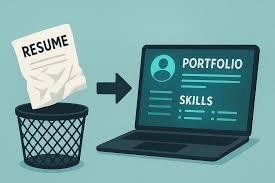
Stop Applying to Everything! How to Define Your Career Direction (Even If You're Undecided)
Stop Applying to Everything! How to Define Your Career Direction (Even If You're Undecided)
The job search can often feel like a desperate game of chance. You open your laptop, stare into the abyss of job boards, and start applying to everything that remotely matches your skills. Marketing analyst? Sure. Project coordinator? Why not. Administrative assistant? Might as well. This "spray and pray" method is a classic mistake—a frustrating cycle that leads to burnout, generic applications, and interviews for roles you don't even want.
If your job search is going nowhere, the problem isn't your resume; it's your lack of defined direction.
Applying to everything signals desperation and a lack of focus. Recruiters can spot a generic application a mile away, and frankly, if you don't know what you want, how can a company possibly decide if you're the right fit? The key to a successful job search is to pause, look inward, and define a clear career direction, even if you still feel undecided.
Step 1: The Great Inventory—What Do You Actually Enjoy?
Before you look at a single job title, you need to understand yourself. Your most fulfilling career path won't be found by following a trend; it will be found by following your energy.
A. Identify Your Peak Flow Moments
Think back to times in your life—in school, volunteering, or even past jobs—when you were completely absorbed in a task. Time flew by, and you felt energized, not drained. These are your peak flow moments.
-
Example: Was it when you organized a massive event? (Signals a passion for logistics and management). Was it when you broke down complex data to explain a problem? (Signals a passion for analysis and communication). Was it when you designed a presentation or created visual content? (Signals a passion for creativity and visual storytelling).
B. Separate Skills from Enjoyment
You might be good at writing reports, but do you enjoy it? Many people confuse competence with passion. Make a list of your most valuable skills and then rate how much you enjoy using each one on a scale of 1 to 10. Your ideal career is at the intersection of your competence and your enjoyment.
C. Define Your Non-Negotiables
What kind of work environment do you need to thrive?
-
Culture: Do you need a highly collaborative, fast-paced team, or do you prefer autonomous, deep-focus work?
-
Impact: Do you need to see the direct results of your work (like a product manager), or are you comfortable with a supporting role (like a financial analyst)?
-
Structure: Do you need clearly defined tasks, or do you prefer to tackle ambiguity and define the path yourself?
Answering these questions gives you a directional compass to filter job listings.
Step 2: The Two-Axis Approach to Defining Your Path
Once you have your inventory, it’s time to move from "I don't know what I want" to "I'm interested in exploring these two avenues." You don't need one perfect job title; you just need to narrow your focus to one or two areas.
A. Define Your Industry Focus (The "What")
Pick a sector you genuinely care about or find fascinating. This could be sustainable energy, health tech, education, finance, or e-commerce. It's much easier to pivot roles within an industry you know than to learn a new industry and a new role simultaneously.
B. Define Your Function Focus (The "How")
Pick a core function based on the skills you enjoy using (from Step 1).
-
If you enjoy analysis and problem-solving: Look at roles in Business Intelligence, Data Analytics, or Operations.
-
If you enjoy connecting people and managing logistics: Look at roles in Project Management, Account Management, or Human Resources.
-
If you enjoy creating content and communicating: Look at roles in Content Marketing, Social Media Management, or Technical Writing.
This creates a targeted search: "I'm looking for a Data Analyst role (Function) in the Health Tech industry (Industry)." This laser focus instantly weeds out 80% of irrelevant listings and allows you to customize your applications powerfully.
Step 3: The Validation Strategy—Informational Interviews
Once you have a defined direction (e.g., "Marketing Analyst in the FinTech space"), your job search stops being about applying and starts being about testing your hypothesis. The best way to do this is through informational interviews.
-
Go Cold, Get Warm: Use LinkedIn to find people with the job title you're considering, especially those who work in your target industry. Send a concise, personalized connection request.
-
Ask for Advice, Not a Job: Your goal is simple: Ask for 15 minutes of their time to learn about their actual day-to-day work. Good Question: "Based on my skills in X and Y, do you think a Marketing Analyst is the right path for me, or is there another role in FinTech you'd recommend?"
-
The Reality Check: An informational interview is the fastest way to validate your chosen path. If five different analysts all describe a job you dread, you know to pivot before wasting time on applications. If they describe a job you love, you've just confirmed your target and gained a valuable contact.
Stop the Madness, Start the Search
The "apply to everything" mentality is the antithesis of a successful job search. It wastes your time, dilutes your energy, and makes you look unfocused. By taking a few days to step back, define your enjoyment, target your search, and validate your path through networking, you can transform your job hunt from a desperate scramble into a strategic, high-conversion mission.
Your next great job is waiting, but you have to know which door you're trying to open.
FAQs on Defining Your Career Direction
1. I'm afraid to commit to one direction. What if I choose wrong?
Choosing a direction is not a permanent contract; it's a temporary focus. The most successful careers involve pivots and changes. By choosing one direction now, you gain clarity, momentum, and relevant experience. Even if you pivot in a year, the skills and network you built will make your next move much easier. The only wrong choice is remaining stuck in indecision.
2. How do I tailor my resume when I only have experience in an unrelated field?
Use a functional resume format and focus on transferable skills. Instead of listing your jobs chronologically, group your past experiences under relevant skill headings like "Data Analysis," "Client Communication," or "Project Management." For instance, if you worked in retail, reframe that as "Successfully managed and tracked daily sales data," to prove your analytical competence.
3. What if I'm interested in two completely different fields (e.g., coding and social work)?
You don't have to choose permanently, but you must choose one to target first. Look at the time commitment required for each. Can you pursue one (like coding) through a part-time bootcamp or side projects while volunteering in social work? Choose the path that is most easily validated or requires the least initial investment, and pursue the other on the side until you gain clarity.




